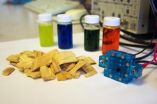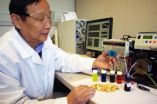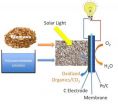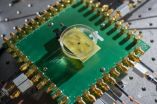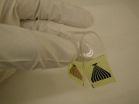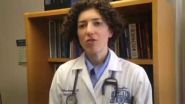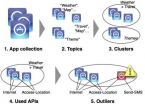(Press-News.org) Although low temperature fuel cells powered by methanol or hydrogen have been well studied, existing low temperature fuel cell technologies cannot directly use biomass as a fuel because of the lack of an effective catalyst system for polymeric materials.
Now, researchers at the Georgia Institute of Technology have developed a new type of low-temperature fuel cell that directly converts biomass to electricity with assistance from a catalyst activated by solar or thermal energy. The hybrid fuel cell can use a wide variety of biomass sources, including starch, cellulose, lignin – and even switchgrass, powdered wood, algae and waste from poultry processing.
The device could be used in small-scale units to provide electricity for developing nations, as well as for larger facilities to provide power where significant quantities of biomass are available.
"We have developed a new method that can handle the biomass at room temperature, and the type of biomass that can be used is not restricted – the process can handle nearly any type of biomass," said Yulin Deng, a professor in Georgia Tech's School of Chemical and Biomolecular Engineering and the Institute of Paper Science and Technology (IPST). "This is a very generic approach to utilizing many kinds of biomass and organic waste to produce electrical power without the need for purification of the starting materials."
The new solar-induced direct biomass-to-electricity hybrid fuel cell was described February 7, 2014, in the journal Nature Communications.
The challenge for biomass fuel cells is that the carbon-carbon bonds of the biomass – a natural polymer – cannot be easily broken down by conventional catalysts, including expensive precious metals, Deng noted. To overcome that challenge, scientists have developed microbial fuel cells in which microbes or enzymes break down the biomass. But that process has many drawbacks: power output from such cells is limited, microbes or enzymes can only selectively break down certain types of biomass, and the microbial system can be deactivated by many factors.
Deng and his research team got around those challenges by altering the chemistry to allow an outside energy source to activate the fuel cell's oxidation-reduction reaction.
In the new system, the biomass is ground up and mixed with a polyoxometalate (POM) catalyst in solution and then exposed to light from the sun – or heat. A photochemical and thermochemical catalyst, POM functions as both an oxidation agent and a charge carrier. The POM oxidizes the biomass under photo or thermal irradiation, and delivers the charges from the biomass to the fuel cell's anode. The electrons are then transported to the cathode, where they are finally oxidized by oxygen through an external circuit to produce electricity.
"If you mix the biomass and catalyst at room temperature, they will not react," said Deng. "But when you expose them to light or heat, the reaction begins. The POM introduces an intermediate step because biomass cannot be directly accessed by oxygen."
The system provides major advantages, including combining the photochemical and solar-thermal biomass degradation in a single chemical process, leading to high solar conversion and effective biomass degradation. It also does not use expensive noble metals as anode catalysts because the fuel oxidation reactions are catalyzed by the POM in solution. Finally, because the POM is chemically stable, the hybrid fuel cell can use unpurified polymeric biomass without concern for poisoning noble metal anodes.
The system can use soluble biomass, or organic materials suspended in a liquid. In experiments, the fuel cell operated for as long as 20 hours, indicating that the POM catalyst can be re-used without further treatment.
In their paper, the researchers reported a maximum power density of 0.72 milliwatts per square centimeter, which is nearly 100 times higher than cellulose-based microbial fuel cells, and near that of the best microbial fuel cells. Deng believes the output can be increased five to ten times when the process is optimized.
"I believe this type of fuel cell could have an energy output similar to that of methanol fuel cells in the future," he said. "To optimize the system, we need to have a better understanding of the chemical processes involved and how to improve them."
The researchers also need to compare operation of the system with solar energy and other forms of input energy, such as waste heat from other processes. Beyond the ability to directly use biomass as a fuel, the new cell also offers advantages in sustainability – and potentially lower cost compared to other fuel cell types.
"We can use sustainable materials without any chemical pollution," Deng said. "Solar energy and biomass are two important sustainable energy sources available to the world today. Our system would use them together to produce electricity while reducing dependence on fossil fuels."
INFORMATION:
In addition to Deng, the research team included Wei Liu, Wei Mu, Mengjie Liu, Xiaodan Zhang and Hongli Cai, all from the School of Chemical and Biomolecular Engineering or the Institute of Paper Science and Technology at Georgia Tech.
CITATION: Wei Liu, et al., "Solar-induced direct biomass-to-electricity hybrid fuel cell using polyoxometalates as photocatalyst and charge carrier," (Nature Communications, 2014).
Solar-induced hybrid fuel cell produces electricity directly from biomass
2014-02-18
ELSE PRESS RELEASES FROM THIS DATE:
Quest for jellyfish robot leads to discovery of bending rules for animal wing, fin tips
2014-02-18
WOODS HOLE, Mass. —A Navy-sponsored project to design a biologically inspired, swimming jellyfish robot has led scientists to the surprising discovery of common bending rules for the tips of wings, fins, flukes, mollusk feet, and other propulsors across a broad range of animal species.
The study, led by John H. Costello of Providence College and the Marine Biological Laboratory (MBL) in Woods Hole, where he is a visiting scientist, is published this week in Nature Communications.
By studying videos of 59 different animals—from fruit flies to humpback whales—propelling ...
Single chip device to provide real-time 3-D images from inside the heart, blood vessels
2014-02-18
Researchers have developed the technology for a catheter-based device that would provide forward-looking, real-time, three-dimensional imaging from inside the heart, coronary arteries and peripheral blood vessels. With its volumetric imaging, the new device could better guide surgeons working in the heart, and potentially allow more of patients' clogged arteries to be cleared without major surgery.
The device integrates ultrasound transducers with processing electronics on a single 1.4 millimeter silicon chip. On-chip processing of signals allows data from more than a ...
'Legal highs,' PMMA and zombie panic
2014-02-18
Recent deaths in both Canada and the UK linked to PMA/PMMA in ecstasy pills has brought public scrutiny to this little known drug. With Canadian producing most of the ecstasy in the North American market, this timely paper (Ecstasy, legal highs and designer drug use: A Canadian perspective) published this week in Drug Science Policy and Law looks at trends in ecstasy adulteration, the facts around PMA/PMMA-linked deaths and explores alternatives to the endless banning of new drugs.
It finds:
In 2007, according to the Health Canada Drug Analysis Service, only 3% of seized ...
A stretchable highway for light
2014-02-18
WASHINGTON, Feb. 18, 2014—For futuristic applications like wearable body sensors and robotic skin, researchers need to ferry information along flexible routes. Electronics that bend and stretch have become possible in recent years, but similar work in the field of optics – communicating with light instead of electrons – has lagged behind. Particularly difficult to engineer have been optics that stretch, lengthening when someone wearing body sensors bends to tie their shoe, or when a robotic arm twists through a full range of motion.
Now a team of Belgian researchers reports ...
Georgia Tech study reveals copyright complexities, social norms in online media creation
2014-02-18
In the age of mashups, fan fiction and content sharing, online media creation has spurred new complexities in copyright, effectively turning the legal concept of "fair use" on its ear, according to a new study from Georgia Tech.
Research into fan fiction and other types of remix communities reveals many legal misconceptions persistent among different groups when applying copyrighted work to their own creations. The research also highlights online social norms – independent of actual law – that guide the use of copyrighted works in fan communities.
For the study, Georgia ...
Clemson researchers develop sticky nanoparticles to fight heart disease
2014-02-18
CLEMSON, S.C. — Clemson University researchers have developed nanoparticles that can deliver drugs targeting damaged arteries, a non-invasive method to fight heart disease.
Heart disease is the leading cause of death in the U.S., according to the Centers for Disease Control and Prevention. One of the standard ways to treat clogged and damaged arteries currently is to implant vascular stents, which hold the vessels open and release such drugs as paclitaxel.
The researchers, led by Clemson bioengineering professor Naren Vyavahare, hope their advanced nanoparticles could ...
Transgender patients discriminated against for health care services
2014-02-18
VIDEO:
Discrimination against transgender people -- as many as one million Americans identify themselves as transgender -- should immediately be addressed by the medical establishment, backed by policy change at the...
Click here for more information.
DETROIT – Discrimination against transgender people –as many as one million Americans identify themselves as transgender – should immediately be addressed by the medical establishment, backed by policy change at the national ...
Frequent school moves can increase the risk of psychotic symptoms in early adolescence
2014-02-18
Researchers at Warwick Medical School have shown that frequently moving schools during childhood can increase the risk of psychotic symptoms in later years.
The study, published in the Journal of American Academy of Child and Adolescent Psychiatry, found that school mobility during childhood heightens the risk of developing psychotic-like symptoms in early adolescence by up to 60%.
Suffering from psychotic-like symptoms at young age is strongly associated with mental health problems in adulthood, including psychotic disorders and suicide.
Professor Swaran Singh, ...
Wisdom of app stores: Early identification of malicious Android apps from Google Play
2014-02-18
"How do I know that the new installed app behaves as described?" asks Andreas Zeller, professor of software engineering at Saarland University. So far experts have identified so-called malicious apps by checking their behavior against patterns of known attacks. "But what if the attack is brand-new?" asks Zeller.
His group seems to have found a new method to answer all these questions. Zeller summarizes the basic idea as follows: "Apps whose functionality is described in the app store should behave accordingly. If that is not the case, they are suspect."
His research ...
Do Guam mantas plan moon parties?
2014-02-18
Several of Hartup's paddler and free diving friends told her about seeing mantas congregating purposefully in an area where surgeonfish were spawning. Since they were able to give her an exact date, Julie was able to calculate the moon phase, which is important as many fish synchronize their spawning with the moon. Using this information she predicted when the spawning event would occur that upcoming year and was there to witness a shoal of spawning surgeonfish accompanied by a fever of mantas.
Hartup's research findings not only highlight important information about ...
